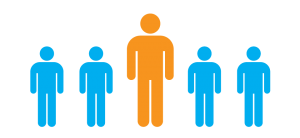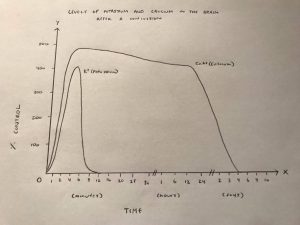One in five Canadians have been concussed from playing a sport according to a recent poll by the Angus Reid Institute.

1 in 5 Canadians have had a concussion from playing a sport. Source: Twitter – Healthy Minds Canada
Within the last 4 years, I have had 3 concussions from playing soccer, making me one of five Canadians to get concussed from a sport. My most recent concussion happened last October and I still have symptoms including: light sensitivity, headaches and trouble focusing. I saw a neurologist during the summer and he explained how chemical influxes of potassium and calcium are the major causes of these concussive symptoms, especially for the first few weeks or even months after.
A concussion is a mild traumatic brain injury from a blow to the head, that causes the brain to move around in the skull. This short video by Smithsonian, describes a concussion in simple terms.
What most of you might not know, is that concussive symptoms are not just from the brain being shaken and bruised. Secondary symptoms, which increase a concussion’s effect, are from the chemical imbalances released when the brain is hit. Free-radical overproduction and ion imbalances decrease the energy that nerves use to function. The ion imbalance prevents the nerve cells from generating energy to recover from the injuries.
A paper by Christoper Giza and David Howa describes how neuronal depolarization and neurotransmitter release delays recovery from concussions and causes secondary symptoms.
Right after the blow to the head, neurotransmitters and ions like potassium and calcium are released in large quantities. Neuronal depolarization, when positively charged ions enter the cell, occurs when potassium ions flow out and calcium ions flow into the cell disrupting the normal concentrations.
The figure below shows the overall trends of these ions during a concussion.

Potassium and calcium levels in the brain after a concussion. Data source: National Athletic Trainers’ Association
The influx of calcium ions disrupt neuron connections, slowing brain processes, causing confusion and trouble focusing. Calcium build-up also prevents mitochondria from making energy, causing headaches.
The potassium ions pushed out of the cells cannot be balanced by the cell’s normal processes. The excess potassium increases depolarization, creating a positive feedback cycle that suppresses the neuron, and significantly slows neuron activity, causing slower thinking and trouble formulating thoughts.
Lastly, neurotransmitter influxes inhibit neuron activity causing temporary memory loss and learning difficulties, for a week up until even 8 weeks after. This release of neurotransmitters in higher amounts causes the initial potassium and calcium ions influx.
Currently, the scientific knowledge available about concussions is limited, so researchers have been looking at the biochemical changes that occur in the brain after a concussion happens. By understanding the biochemical processes of concussions and how long these effects last, researchers can make a positive impact on athletes’ health and well-being.
-Jessica Hasker
